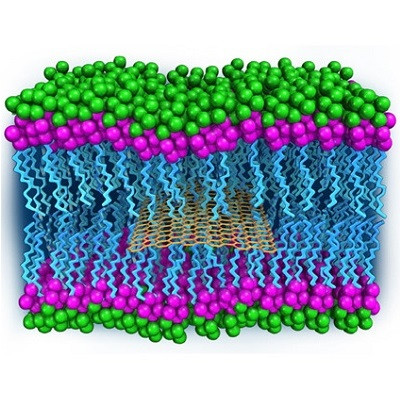
2019-07-29
Visited : 4192
Chinese researchers have investigated the diffusive dynamics of graphene oxide (GO) on the lipid bilayer of a cell membrane to develop new two-dimensional nanocarriers. They showed that GO could be used to make nanocarriers, biosensors, and electronic circuits in biological systems.
The cell membrane plays a significant role in cellular functioning, which manages the flow of various materials and compounds into the cell. The membrane is made of lipid bilayers within which nanoscale particles such as proteins are in a constant state of motion. Understanding the diffusive dynamics of nanoparticles on the cell membrane is essential for cellular functioning and immunity.
In recent years, some studies have also been conducted on the co-delivery of medication and siRNA in the cell aided by graphene oxide, which can be used in the gene therapy of cancer cells and pathogens. In these researches, the transport of nanomaterials within the cell membrane is a critical step. Hence, several models have been proposed to investigate the diffusive transport of spheres or other three-dimensional nanoparticles on the cell membrane; however, the transport of two-dimensional materials such as graphene and transition-metal dichalcogenides is not well understood.
The researchers at the Tsinghua University, in collaboration with researchers from several Chinese universities, examined the dynamics of the transport of two-dimensional nanomaterials on the cell membrane. They used graphene oxide (GO) sandwiched inside the cell membranes to explore the behaviour of this two-dimensional nanostructure. This research group also simulated the translation or diffusion dynamics of this nanomaterial.
They showed that the translational transport of GO sandwiched inside cell membranes changes from Brownian to Lévy and even directional dynamics, governed by various states of a sandwiched GO-induced pore in the leaflet of the membrane. Computer simulations also confirm the diversity of the behaviour of GO in the cell membrane and the relationship between the diffusion dynamics of GO and the pore structure. The research group found that the pore induced by the entry of GO into the membrane can be stable, unstable, or metastable. They believe that these results can be extended to other two-dimensional nanomaterials.
But what is the application of this achievement? The researchers believe that the results of this study could be used to design two-dimensional nanocarriers, which can transport along the cell membrane for precision drug delivery. Considering the importance of nanocarriers behavior and the need to increase their productivity and efficiency, it is necessary to carefully examine their behaviour in a cellular environment prior to the construction of nanocarriers to determine their functional mechanism. These data can be used to increase the precision of drug delivery and the stability of the nanocarriers on the path to the desired site.
Such superstructures could also be used as a platform for the development of biosensors and electronic circuits where the lipid bilayer separates the sandwiched GO from the electrically conducting media around it. Putting GO in the lipid environment is a good opportunity to make biosensors, which allow the diagnosis of bioindicators. Bioelectronics science is one of the most exciting topics that has been attracted to great scientific consideration. Two-dimensional nanostructures that have been isolated inside a living environment provides researchers with an excellent opportunity to use it for bioelectronic development.
The results of this study have been published in the Science Advances journal with the title of "Transport of a graphene nanosheet sandwiched inside cell membranes."